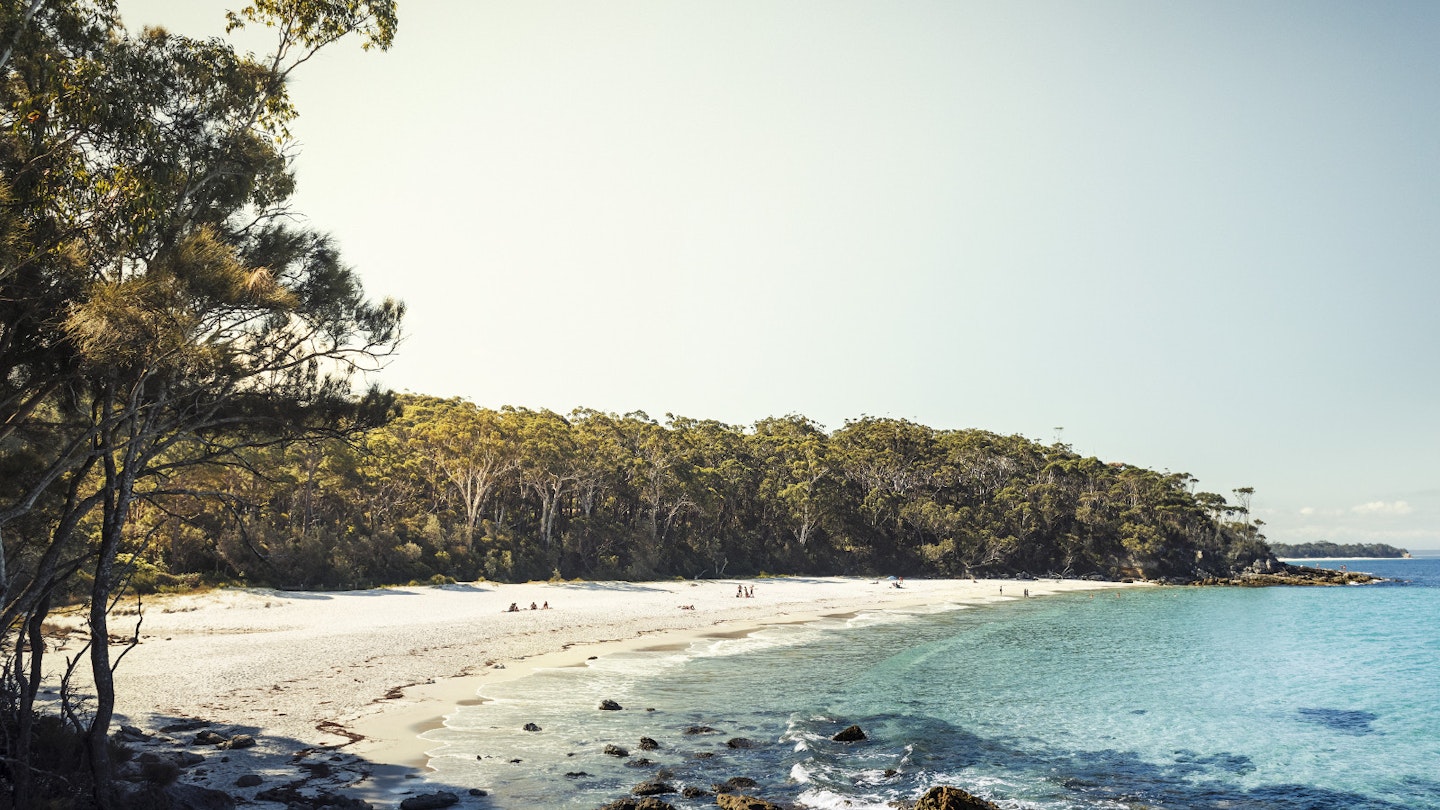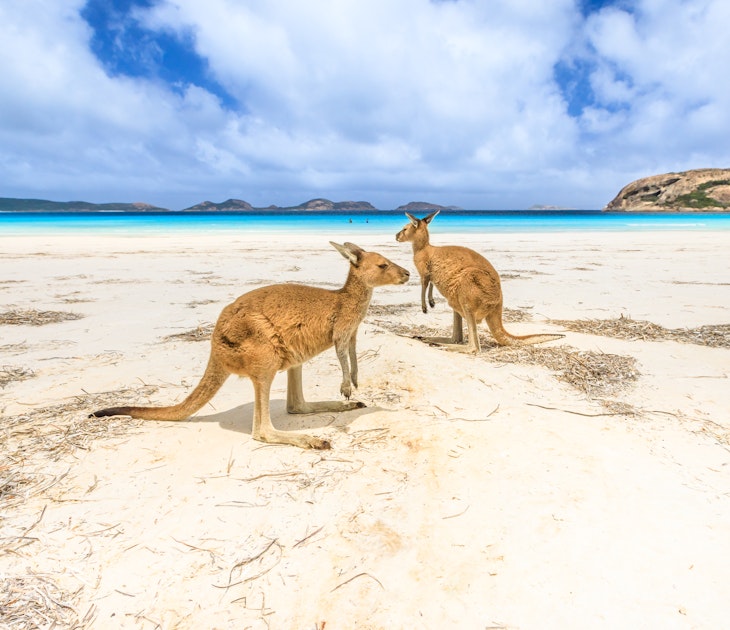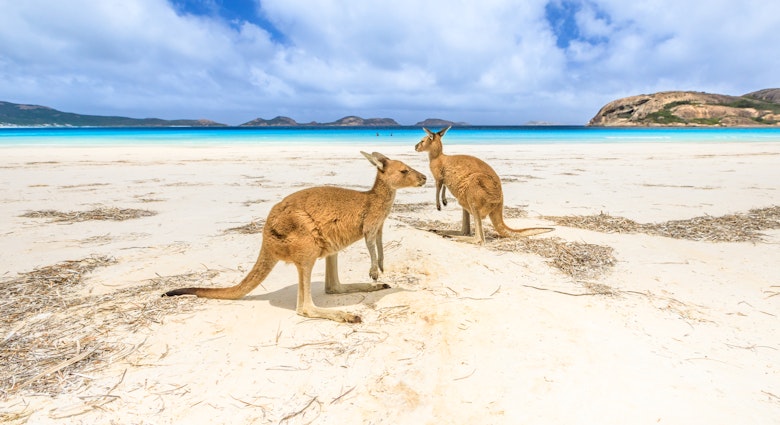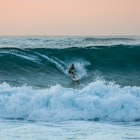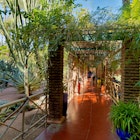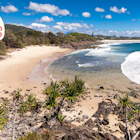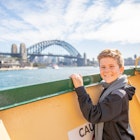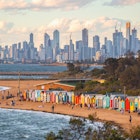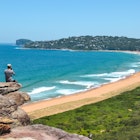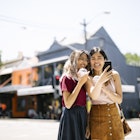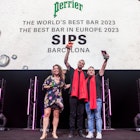The light is bronze, shadows long, and beside Sydney’s most famous building a throng of people is drinking at the Opera Bar. From here, they are close enough to see that the Opera House’s sails are tiled in a zigzag pattern like the fletchings on an arrow. To its western flank, the iron girders of Sydney Harbour Bridge loom, solid. Beyond, the glowing sun sinks towards the horizon.

These may be the city’s most recognisable icons, but here is not the place to take Sydney’s pulse. For that, inner-city neighbourhoods beckon. In Surry Hills, grand Victorian terraced houses with wrought-iron detailing stand beside converted warehouses on narrow streets, and rainbow flags dangle from balconies. On Reservoir Street, the windows in coffee shop Single O open up to the pavement. Every seat is taken, and a queue snakes out the door. A young woman in running clothes, phone to her ear, perches on a stool, iced coffee in hand; on the street, a man awaits his morning flat white, his dry-cleaning folded over his arm. The staff exchange friendly greetings with him; this, evidently, is his morning ritual.

And ritual is the word: this is a city that treats lifestyle as a religion. Collectively, Sydney’s once-rough neighbourhoods are now home to popular restaurants, markets and bakeries. To Surry Hill’s southwest, the Redfern area is also punching through its scrappy reputation. ‘People used to shoot up outside the shop when we first moved here,’ says Brian Fitzgerald of Chee Soon & Fitzgerald, an arts and textiles shop that sells bold fabrics – prints from Finland, geometric patterns from east Africa, elegant Japanese blossom designs. It’s a different story around here now: shops like this one and nearby Seasonal Concepts, an Aladdin’s cave of vintage ephemera – among them a pot of silky feathers and a full-sized stuffed zebra – attract a new wave of locals.

‘There’s an energy to these streets,’ says Sophia de Mestre, a curator and visual artist who leads walking tours here with local company Culture Scouts. ‘They feel like my spiritual home.’
They’re also the spiritual home of Sydney’s indigenous community. Much of the street art that Sophie points out as we wander Redfern’s jasmine-perfumed side roads speaks to the Aboriginal presence here, especially the ubiquitous colours of the Aboriginal flag: red for the earth; black for the skin; yellow for the sun. Nearby, an installation by indigenous artist Daniel Boyd features thousands of mirror circles on a black wall, distorting the world back on itself. ‘To me it’s about our capacity for self-reflection,’ says Sophia, gazing on it appreciatively.
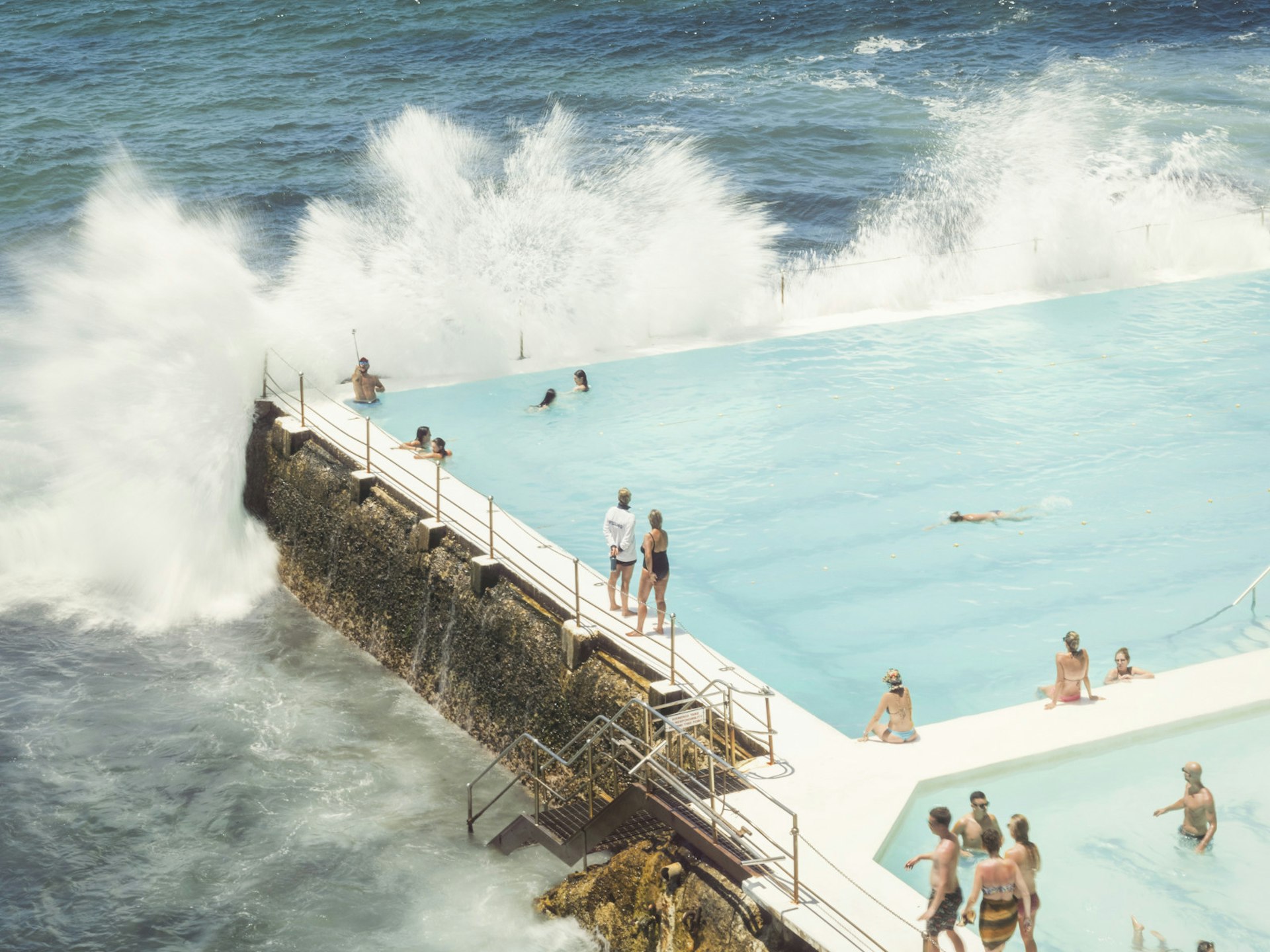
Self-reflection, albeit of a different kind, is alive and well to Sydney’s eastern fringes, which back up against the giant Pacific Ocean. On the weekend Bondi Beach teems with buff city boys, paddlers and lifeguards, children playing tug-of-war. Surfers loll in the water, waiting for a breaker. Giggling girls splash in the shallows, arm-in-arm. To every aspect there is a tangible, studied sense of the carefree.
And with good reason. After all, this is Sydney: the sky is blue, the surf is up and the coffee is good.

From somewhere deep within the trees, a bird trills like a high-pitched violin. Mossy trunks lurk damply around, and the minty essence of eucalyptus fills the forest. A sharp whistle, like that of a farmer summoning his sheepdog, slices through the air. A third birdcall joins the cacophony, this one sounding something like a comic-book shoot-out: pew-pew-pew.
Around a corner, the source of this din presents itself: a male lyrebird, his brown tail plumage trailing behind him as he scratches in the earth for worms, cocking his head from side to side. These creatures are known for their mimicking of other birds’ songs, as well as other forest noises and artificial sounds.
Here in Morton National Park he has plenty of places to draw inspiration. Kookaburras, with their riotous laughter, and yellow-tailed black cockatoos are among the many bird species to live here; wombats snuffle about, and platypuses plop into the water. For all that, though, the park is remarkably quiet. On the forest floor the odd tenacious flower blooms among scrubby grasses. A black and orange butterfly bobs around like the tip of a conductor’s baton. The walking trail leads out to a viewing platform, where the forest drops away to a deep and rugged gorge of blue-tinged greenery, stretching out to the horizon like a lost world.
Into the canyon topples Fitzroy Falls, though today, after a season of little rainfall, it emerges from foliage shyly, and drops in a steady flow rather than a thundering cascade.

In the Southern Highlands, trees are a compelling visitor attraction. At nearby Illawarra Fly, the forest canopy is revealed on a 1,500-metre-long treetop walk along cantilever walkways that squeak and sway with each step. From the central viewing point, Knights Tower, the panoramic view of pastureland looks for all the world like a corner of English countryside.
This cloak of rich rainforest exists just 70 miles south of Sydney. The drive between them gives no hint of the landscape to come, although the coastal road throws up its own spectacular views down Australia’s eastern seaboard on the Grand Pacific Drive, including Sea Cliff Bridge, a stretch of road which clings to the coastline in an elegant S-shape.
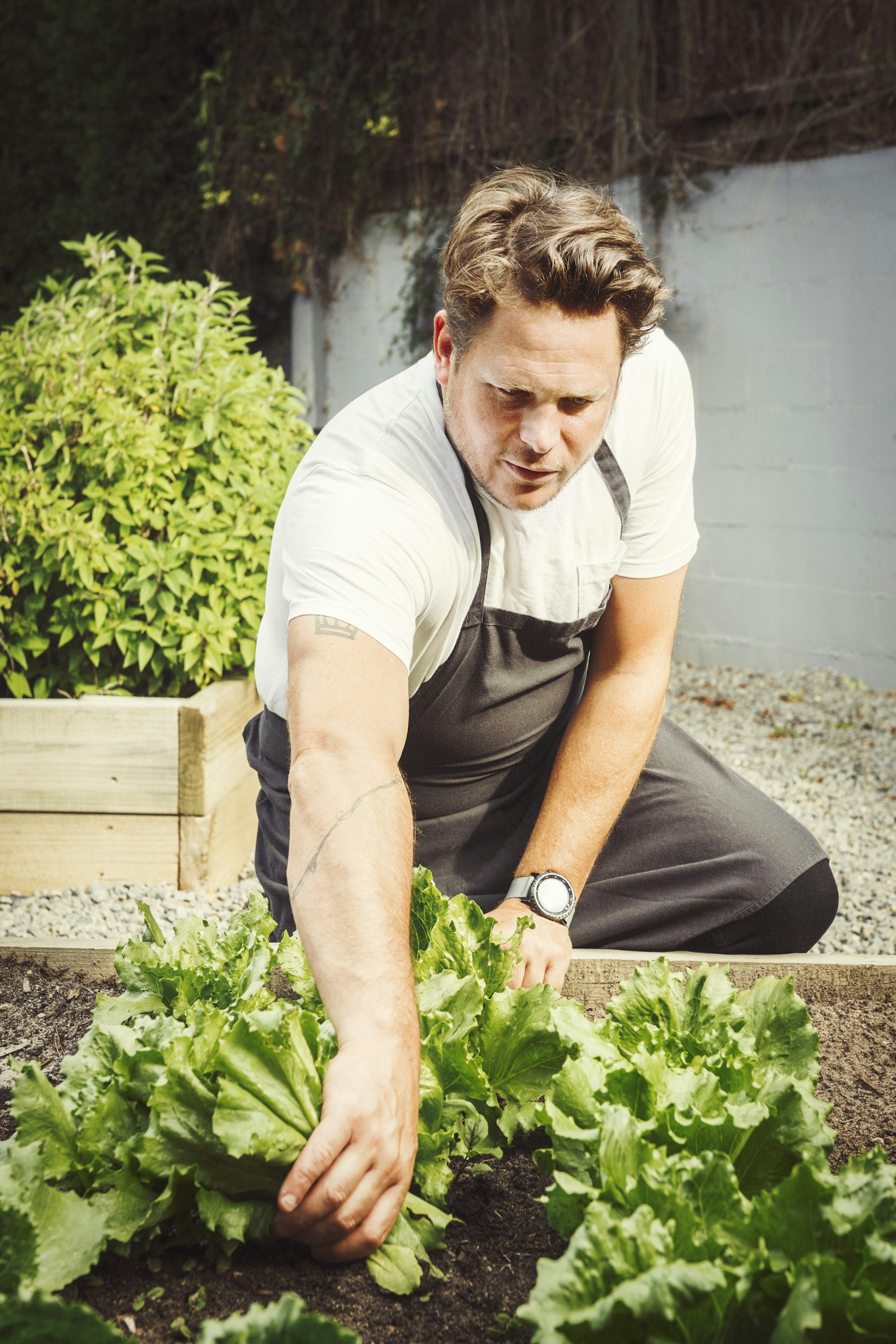
For James Viles, chef and owner of restaurant Biota, keeping urban life at arm’s length is essential. ‘It’s not possible to achieve our kind of modern rustic approach in a city,’ he says as he wanders through the kitchen gardens, looking for ingredients for tonight’s menu. ‘We strive for localism. We strip things back.’ He plucks yarrow from its bed, and tugs a butter lettuce free. ‘This’ll do nicely,’ he murmurs to himself.
Back in the kitchen, he wilts the lettuce over coals, and in a matter of moments has served it up on fish roe, topped with gathered leaves. The fish roe cuts beautifully through the earthiness of the leaves. At Biota, 80 per cent of the ingredients – including the fish roe – is wild. ‘We spend a lot of time in the forest, hunting animals, fishing, foraging. Half our time is spent outdoors. That’s how we like it.’
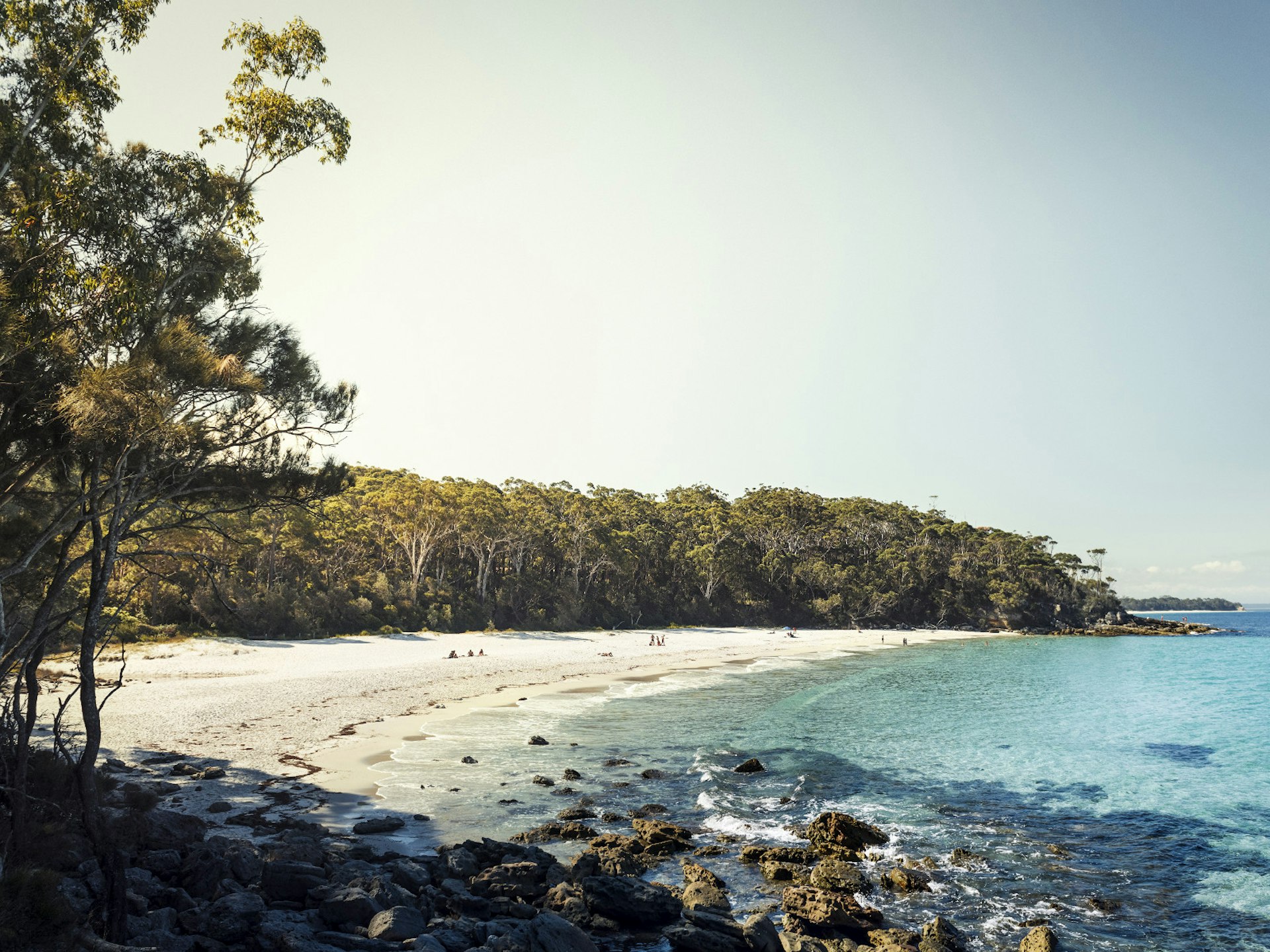
‘Weather’s not great today,’ says Sam Cardow, appraising the skies. He’s standing outside Pelican Rocks, his fish and chip café in the fishing village of Greenwell Point. Apart from a few wispy clouds, there is a dome of unbroken cerulean blue above us, and the sun beams down. Here on New South Wales’ Shoalhaven coast, it seems expectations run a little higher than average.
The region’s glitzy drawcard is Jervis Bay, 20 miles to the south. With some of the finest, whitest sands of anywhere in the world, its beaches throng with sunbathers and campers during the summer. A shady trail leads between the beaches, making it easy to find a quiet spot of sand. To its southern end is Greenfield Beach, screened by gum trees from everything but its ocean stage. There’s barely a breath of wind, and the floury sand squeaks with every footstep across it. A family of three stands in the surf, gazing out to the cobalt expanse in front of them; searching, perhaps, for a telltale friendly fin.
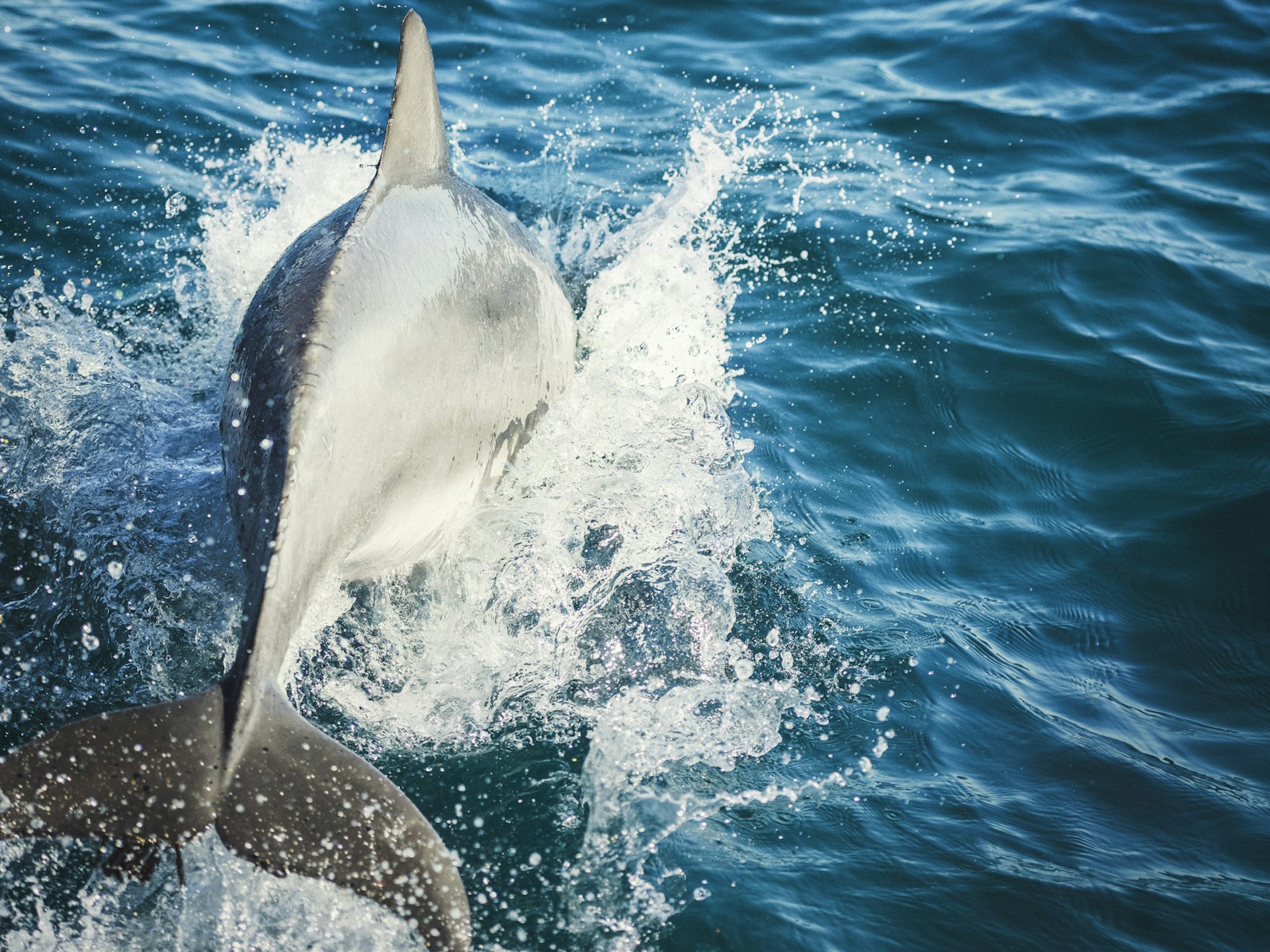
Around 100 bottlenose dolphins live in Jervis Bay. Pods can often be seen from the shoreline, but for a closer encounter, boat company Jervis Bay Wild leads wildlife-spotting tours on the water, from where it’s easier to admire the hugeness of these skies, the changing textures of the seas, and between the blues, the faultless white and green keyline of beach and trees. As the boat sets off and the water deepens from bright aqua to sapphire, all eyes scan the sea, necks craning hopefully. Between late May and November, 30,000 whales migrate along these shores, but today the resident dolphins are centre-stage. When the first fin is glimpsed alongside, a cry goes up, and the boat’s engine is reduced to a hum. ‘There’s a baby,’ points out the captain, ‘do you see? And that’s its mother.’ A group of them seem to race one another to the boat’s bow before breaking the surface in a joyful splosh. Below the water, one dolphin rotates its body, its eye peering up at the sky and the faces smiling down from the boat. It looks like it’s enjoying all the attention.
Jervis Bay wears its natural beauty like a badge of honour, but the region’s waterbourne bounties extend beyond white-sand razzle-dazzle. Back at Greenwell Point, one of the leading seafood ports in the county, Sam’s unassuming café has been voted New South Wales’ best fish and chip shop, much to his delight. ‘We just keep things simple,’ he says, a little bemused.
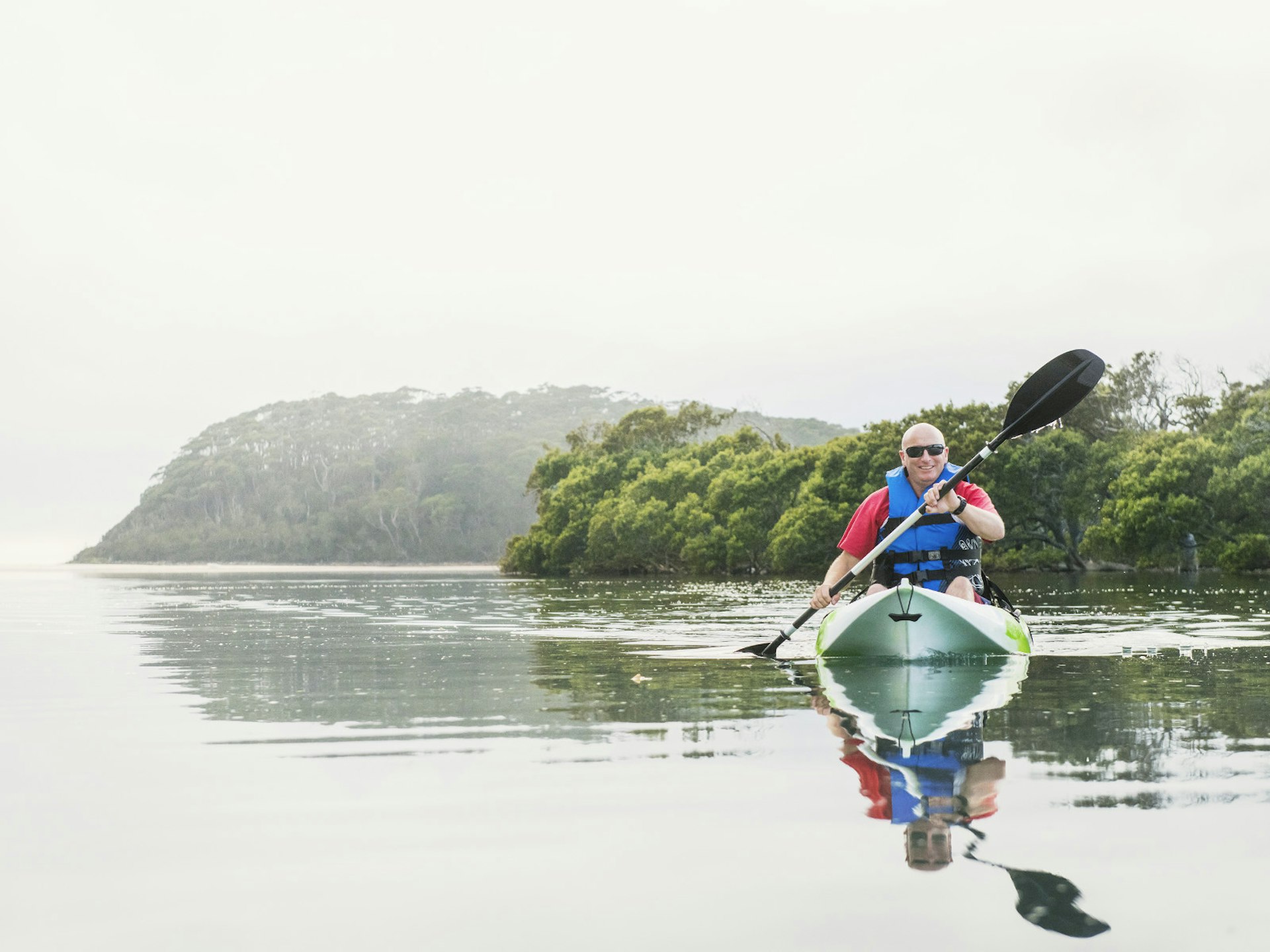
Further down the coast at Mollymook are yet more beaches, but also pretty, unspoilt rivers and waterways. On the quiet Narrawallee inlet, local watersports expert Walking on Water leads kayaking trips on which, with no ocean currents to battle against, the water is still enough to coax out its shyer residents. A baby ray drifts past as we swash along, and in the shallows, sheltered by mangrove trees, the almost-camouflaged blob of an octopus is betrayed by its shiny round eyes. Slowly, it unfurls one tentacle and reaches for a nearby shell. We watch it for a few minutes, then paddle the return journey with the sun on our backs.

In the middle of Pambula River, a man called Sponge is standing in waist-deep water, inspecting a netting bag filled with gnarly oysters. His name, in fact, is Brett Weingarth, but his nickname has stuck – even the boat trips he runs are called Captain Sponge’s Magical Oyster Tours.
Along this stretch of coastline, some of the world’s best oysters are farmed in estuaries and river inlets. Kings of them all are the Sydney rock oysters, which have been feasted on here for tens of thousands of years; Sponge points out ancient Aboriginal shell middens (rubbish heaps) on the banks as we motor upriver in a punt, touring his oyster farm. He’s been a farmer, of sorts, all his life. ‘I used to be a sheep farmer. But oyster farming suits the way I want to live: no fertilisers, no sprays, and the oysters won’t kick a trough to bits and ruin your neighbour’s paddocks.’

He shucks open an oyster pulled just moments ago from the water, deftly freeing it from its shell with a flick of his knife. ‘Taste it: you won’t find fresher!’ The salt hits the palate first, followed by rich butteryness. The texture is meaty, like fillet steak. It’s delicious.
Oysters are a big part of life here, and not just for farmers. ‘We pair our beers here with oysters,’ says Rob Barber of Longstocking Brewery, down the road in Pambula. He brews on a tiny site where, alongside sharp ginger beer, he tries out batch brews and barrel-aged beers, to match the local oyster flavours. Simplicity is key. ‘We do everything ourselves. We fill and cap every bottle; we even stick on the labels.’

Six hours’ drive from Sydney is distance enough to keep most things small-scale, but the city creeps ever closer. Fifty miles from Pambula, the harbour town of Bermagui may be a sign of things to come further south. ‘There’s definitely change in the air,’ says Sophie Rogers, manager and co-owner of restaurant Long Time No Sea with her partner, chef Will Wade. ‘There’s an amazing coffee shop and bakery in town now. The good thing is that Bermie is surrounded by national parks, so we can’t grow bigger – only better.’
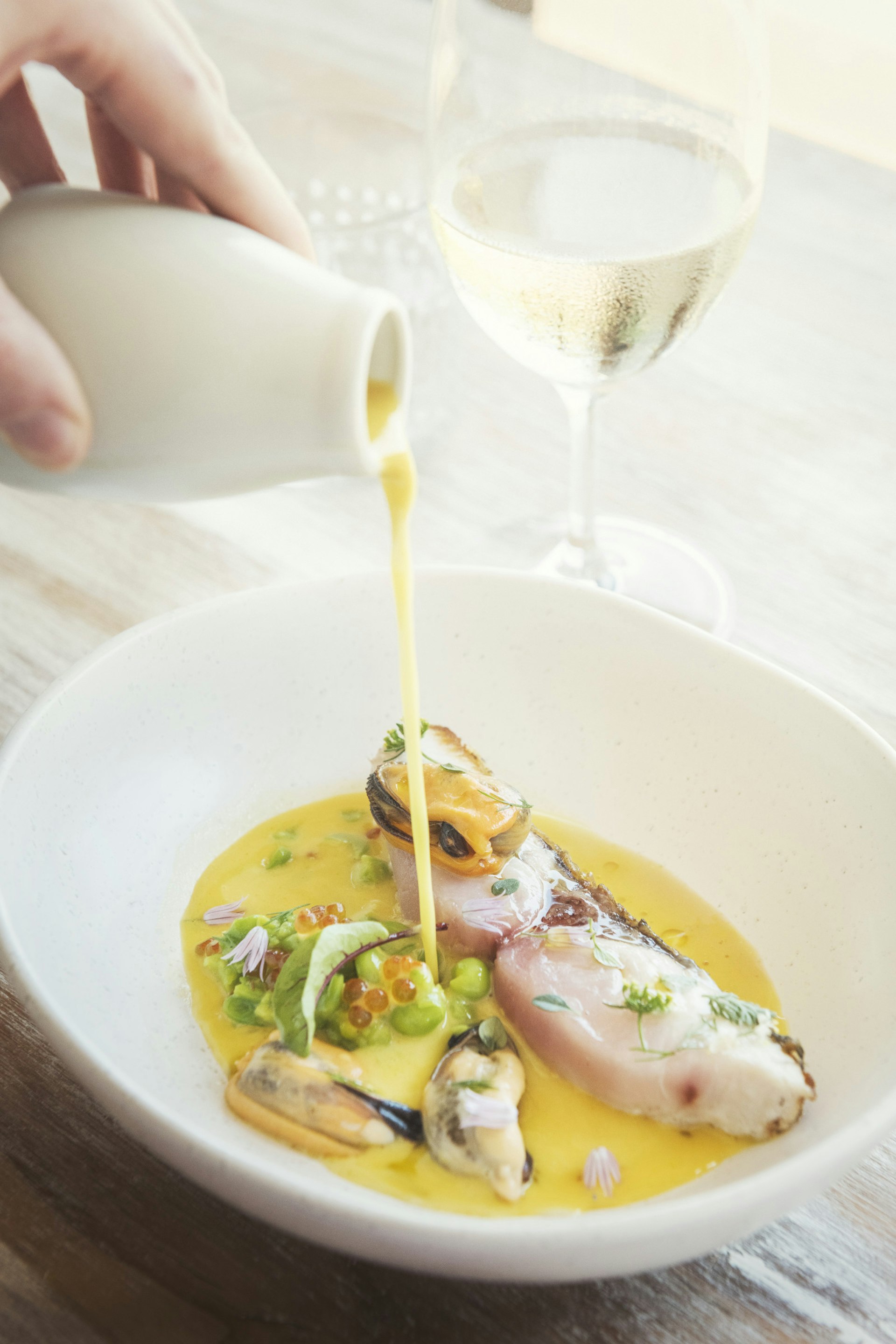
Sophie and Will have been here just two years. Despite that, they have been overwhelmed by the warm Bermagui welcome. ‘Our neighbours pop by to bring us homegrown herbs, rhubarb, lemon myrtle – anything surplus from their own gardens.’ Today, Will is serving kingfish in a seafood broth. ‘I have to use what’s available – if it’s too windy, the clam guy can’t go out, so I have to think: what else can I use? It keeps me on my toes.’
Outside the restaurant’s great folding windows, it’s a warm, blustery sort of a day, and the pastoral view stretches out from edge to edge. The view is, in fact, a strong ambassador for the diverse and often epic homelands of New South Wales’ South Coast: fecund hillocks, artichoke-green woodlands, pretty coastal townships and, behind it all, the sweeping sugar-dusted fringes of the ocean, its powerful mass reaching back to the horizon and beyond.
This article appeared in the March 2018 edition of Lonely Planet Traveller Magazine. Jessica Cole travelled to New South Wales with support from Discover New South Wales. Lonely Planet contributors do not accept freebies in exchange for positive coverage.
